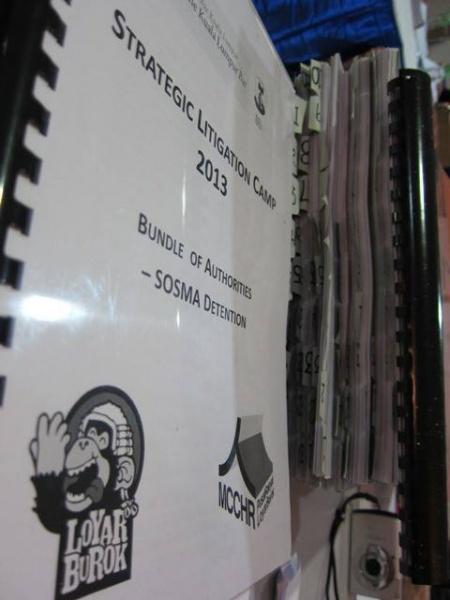Alyssia Loh shares her experience at the Strategic Litigation Camp 2013.
Dick the Butcher in Henry VI speaks the famous line, “The first thing we do, let’s kill all the lawyers”. Such lampoon is uttered with intention to eliminate lawyers as guardians of independent thinking, and thus underscoring the important role that lawyers can play in society. However, inadequate knowledge of law and human rights, inconsistent implementation of human rights and lack of coordination among institutions concerned with law and human rights were circled as the three key challenges in the implementation of human rights in Malaysia, according to a survey conducted at the Strategic Litigation Camp (SLC) which was held from 21st June 2013 to 23rd June 2013 at Firefly Resort, Kuala Selangor.
The SLC had brought together young lawyers, pupils and law students from Penang, Terengganu, Selangor, Malacca, the United States of America and France for three main purposes: to impart legal skills in the practice of constitutional and human rights law; to generate and sustain interest in strategic litigation; and to involve younger participants in upholding of the cause of justice without fear or favor and assisting the public in all matters related to the law and administration of justice.
The first day of the SLC started off with an introduction to strategic litigation which I understood to be a method that brings about significant changes in law, practice or public awareness via taking certain cases to court. Most of the activities in the SLC thereafter were ice-breakers and team building between the participants. We were instructed to chart the 10 most significant events in our lives and what we desire to achieve from this workshop and to share the same with the other participants; none of these can be further revealed herein due to the plea of safe haven under Article 19 of the Universal Declaration of Human Rights (UDHR) (freedom of opinion), one of the ground rules we successfully lobbied to be adopted in the SLC. It is interesting to note that we had been given creative license to set the ground rules of the SLC in terms of human rights, including but not limited to non-restraint of toilet breaks and the right to have fun in accordance with Article 5 (freedom from torture) and Article 24 (the right to rest and leisure) of the UDHRrespectively.
The facilitators then divided us into three groups for discussion and preparation of the written submission for the impending moot in respect to the charge of the Security Offences (Special Measures) Bill (SOSMA) against Mohd Hilmi Hasim, the watching brief in the case in relation to the enticement of Daphne Iking and the unilateral conversion affecting the children of Indira Gandhi respectively. Later we took a slow trip down the river beneath the full moon to catch a glimpse of the twinkling fireflies before burrowing ourselves into the bundles of cause paper and authorities that evening.
On the second day of the SLC, we were reshuffled into different groups and introduced to human rights and the United Nations’ structure as well as the practical application of the same in strategic litigation. The highlight of the day was the mooting that evening. The moot hall was buzzing with excited chatter when the mock bailiff, Sarjan Huskie announced loudly the commencement of the moot proceeding. The mooting judges gallantly marched into the hall and called all matters into session. I was a bundle of nerves when I first submitted in front of said judges. However, the judges were adorably strict in their judgment and gave all of us their opinions on modes to improve our advocacy and conduct effective communication of our cases to actual judges. As the day draws to an end, some of us played a highly addictive card game called Politiko (created by LoyarBarang) while the rest of us chilled beneath the gazebo, talking about everything possible beneath the stars.
On the last day of the SLC, the facilitators briefly reflected on the weekend’s learning and shared how we can carry our key performance pledges. I have gained knowledge in respect to strategic litigation and human rights, but most importantly I had the honour of making new friends of like ideals. Strategic litigation may not stand on its own without support and teamwork, and the workshop had portrayed the same by consistently requiring us to work together with different people. A fight for human rights may seem akin to fighting Goliath. However, it is my opinion that even Goliath may fall if we are armed with strategic litigation as our weapon, with law, wisdom, social conscience, determination and support as our small but effective projectiles.
Featured image is by Justine Tan.

